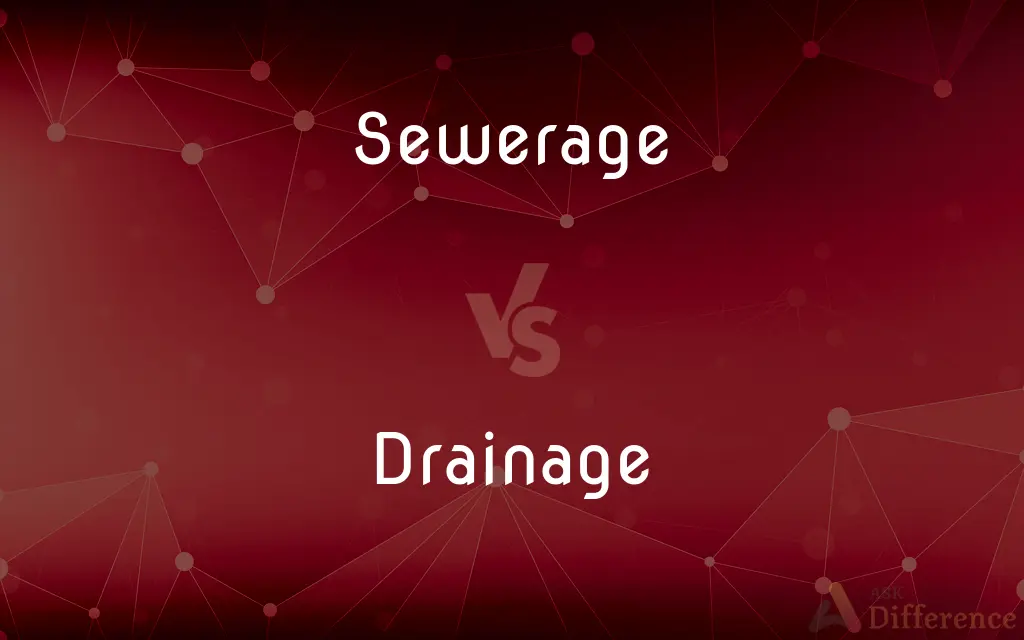Sewerage vs. Drainage — What's the Difference?
By Tayyaba Rehman & Maham Liaqat — Published on February 27, 2024
Sewerage refers to the system of pipes and facilities for transporting sewage, while drainage is the system for removing surplus water. Sewerage deals with waste, drainage with water management.

Difference Between Sewerage and Drainage
Table of Contents
ADVERTISEMENT
Key Differences
Sewerage systems are specifically designed for the collection, transport, treatment, and disposal of sewage, which is waste water and excreta conveyed in sewers. These systems play a crucial role in urban sanitation, preventing the spread of diseases by safely managing waste materials. Sewerage includes physical infrastructure like pipes, pumps, screens, and treatment plants aimed at maintaining hygiene and public health.
Drainage systems, on the other hand, focus on managing water that accumulates from rain, surface runoff, or ground water. Their primary purpose is to prevent waterlogging of the land and protect structures from water damage. Drainage systems can be natural or artificial, including channels, ditches, storm sewers, and other constructions that direct excess water away from urban, agricultural, or industrial areas.
A key difference between sewerage and drainage is their content. Sewerage systems deal with contaminated water that requires treatment before being released into the environment. This necessitates complex and often costly treatment facilities to remove pollutants and hazardous substances. In contrast, drainage water might not always require treatment, as it is often clean or only mildly polluted, and can be directly discharged into water bodies or absorbed into the ground.
Another distinction lies in their engineering and design. Sewerage systems are closed, requiring airtight pipes and controlled environments to prevent leaks and odors, and to ensure that waste is transported safely to treatment facilities. Drainage systems may be open or closed, designed to efficiently channel water away from specific areas while managing issues like erosion and sedimentation.
The impact on public health and environmental protection differentiates them. Sewerage systems are critical for preventing waterborne diseases and protecting water quality by treating sewage. Drainage systems, while also important for public health, primarily focus on preventing flooding and erosion, contributing to the overall safety and sustainability of developed areas.
ADVERTISEMENT
Comparison Chart
Purpose
Transport and treatment of sewage.
Removal of surplus water.
Content
Waste water and excreta.
Rainwater, surface, and ground water.
System Type
Closed, with treatment facilities.
Can be open or closed, not always requiring treatment.
Engineering Focus
Containment and sanitation.
Water management and flood prevention.
Public Health Impact
Prevents waterborne diseases.
Prevents waterlogging and protects structures.
Compare with Definitions
Sewerage
It includes pipes and pumps.
The sewerage network's pipes and pumps are regularly maintained.
Drainage
Drainage prevents waterlogging.
Proper drainage systems are essential in flood-prone areas.
Sewerage
Sewerage ensures safe sewage disposal.
The new sewerage system significantly reduced local pollution levels.
Drainage
Drainage protects infrastructure.
Effective drainage systems safeguard roads and buildings from water damage.
Sewerage
Sewerage requires complex infrastructure.
Upgrading the sewerage infrastructure has improved public health.
Drainage
It includes storm sewers.
Storm sewers are an important component of urban drainage.
Sewerage
It involves waste treatment.
Sewerage plants are crucial for turning waste water into reusable water.
Drainage
It channels excess water.
Drainage ditches were constructed to direct rainwater away from the fields.
Sewerage
Sewerage protects water quality.
Efficient sewerage systems prevent harmful pollutants from reaching rivers.
Drainage
Drainage can be natural or artificial.
Artificial drainage systems supplement the area's natural drainage capacity.
Sewerage
Waste matter carried away in sewers or drains
Drainage
A natural or artificial means for the removal of fluids from a given area by its draining away.
Sewerage
The material collected in, and discharged by, sewers.
Drainage
The system of drains and their operation, by which superfluous water is removed from towns, railway beds, mines, and other works.
Sewerage
Removal of waste materials by means of a sewer system.
Drainage
The act, process, or means of drawing off the pus or fluids from a wound, abscess, etc.
Sewerage
A waste pipe that carries away sewage or surface water
Drainage
The action or a method of draining.
Sewerage
A network of sewer pipes that geographically transfers wastewater; a sewer system.
Drainage
Area or district drained; as, the drainage of the Po, the Thames, etc.
Common Curiosities
How do sewerage and drainage systems differ in purpose?
Sewerage systems manage waste to protect public health, while drainage systems manage water to prevent flooding and water damage.
What is sewerage?
Sewerage is the system involved in the collection, transport, treatment, and disposal of sewage.
Can drainage water be part of sewerage systems?
Generally, drainage water is kept separate from sewerage to avoid overloading treatment plants, but in combined systems, they can mix.
Do all areas have both sewerage and drainage systems?
Most urban areas have both, but their complexity and coverage can vary based on local needs and resources.
What is drainage?
Drainage refers to the system for removing or redirecting surplus water from an area.
How do sewerage systems impact public health?
They significantly reduce the risk of waterborne diseases by safely managing sewage.
What's the difference between surface drainage and sewerage?
Surface drainage deals with removing excess water from surfaces, while sewerage involves the management of waste water.
How do sewerage systems contribute to sustainability?
By treating and sometimes recycling waste water, they conserve water resources and protect ecosystems.
Why is it important to treat sewage?
Treating sewage prevents environmental contamination and the spread of diseases.
Can drainage systems contribute to environmental issues?
If not properly managed, drainage systems can lead to erosion, sedimentation, and pollution of water bodies.
Why is it important to separate sewerage from drainage?
Separation prevents treatment systems from being overwhelmed and reduces treatment costs.
What role do drainage systems play in agriculture?
They prevent soil erosion and waterlogging, crucial for crop health and yield.
Can modern technology improve sewerage and drainage systems?
Yes, technologies like smart sensors and AI can enhance efficiency and responsiveness.
Are sewerage and drainage systems expensive to maintain?
Yes, both systems require significant investment for construction, maintenance, and upgrading.
How do climate change and urbanization affect these systems?
They increase the strain on both systems, requiring adaptive measures to handle extreme weather and urban sprawl.
Share Your Discovery

Previous Comparison
SQL vs. TSQL
Next Comparison
Pepsi Diet vs. Pepsi Zero SugarAuthor Spotlight
Written by
Tayyaba RehmanTayyaba Rehman is a distinguished writer, currently serving as a primary contributor to askdifference.com. As a researcher in semantics and etymology, Tayyaba's passion for the complexity of languages and their distinctions has found a perfect home on the platform. Tayyaba delves into the intricacies of language, distinguishing between commonly confused words and phrases, thereby providing clarity for readers worldwide.
Co-written by
Maham Liaqat












































